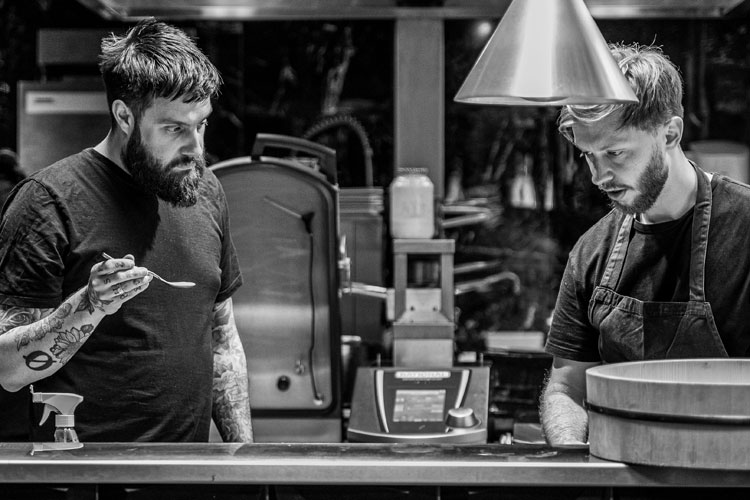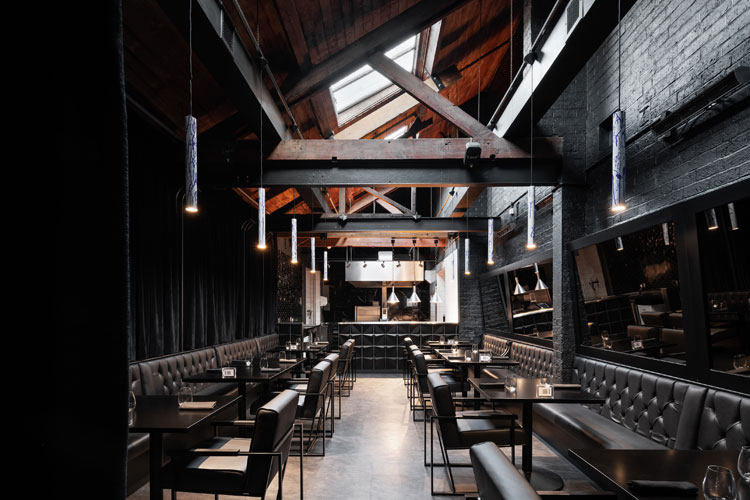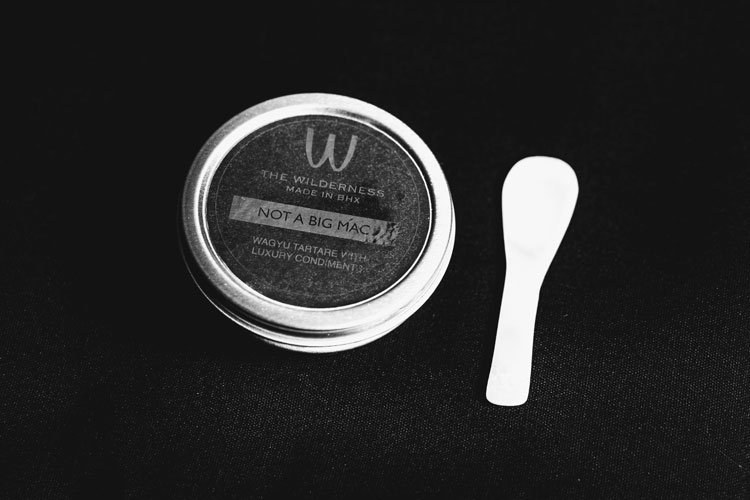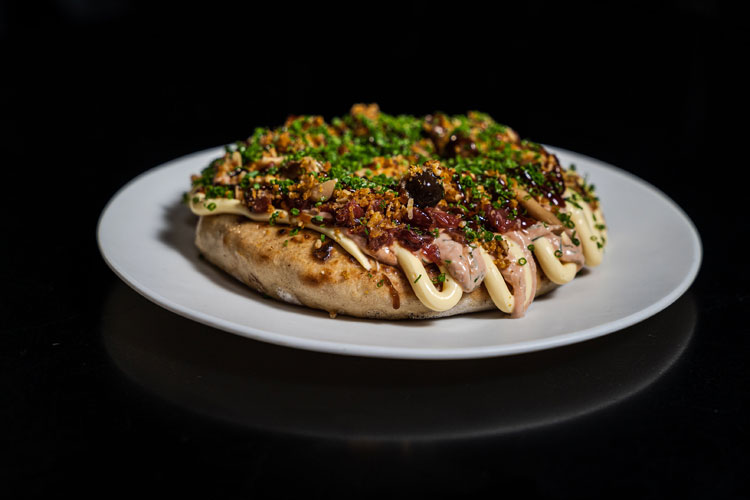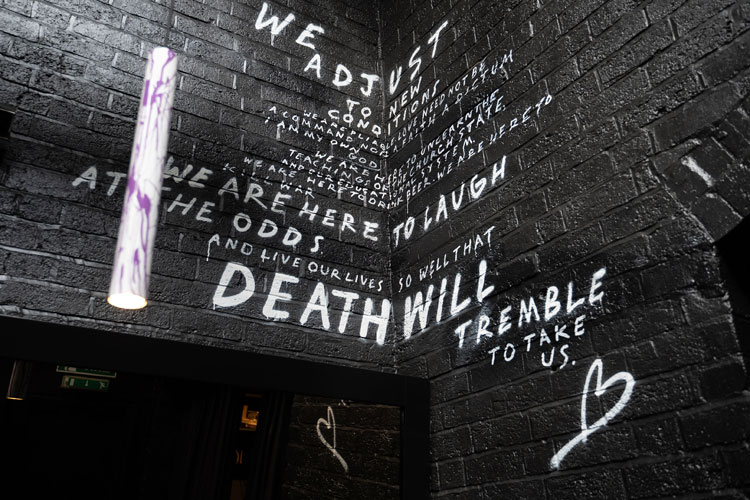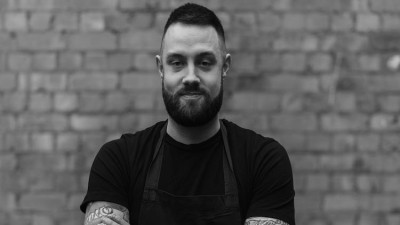Alex Claridge: “I’m an anarchist in the kitchen”

Alex Claridge could be the perfect chef interviewee. Opinionated, sardonic and at times wickedly funny, dead pan, self-deprecating but also obviously very intelligent and eloquent, his acute answers to my questions come quickly and unfiltered.
Dressed head to toe in black and with a black beard to match, Claridge channels a rock look (the image of him with a snake draped round his neck is a strong one) while speaking with the fluency of a lawyer in court. Meet him in a dark alley and you could be forgiven for thinking you might get your head kicked in, whereas he’s more likely to engage you in a philosophical debate. I’ve come to talk to him about The Wilderness, his Birmingham restaurant that debuted on Dudley Street in spring 2016 before moving to the Jewellery Quarter two years later, but we also end up discussing the future of fine dining, the shift in the perceptions of luxury, and the genius of Alexander McQueen.
But first to The Wilderness, a restaurant that has attracted interest and acclaim not just for its playful food but for its location in a restored factory where the all-black dining room throbs to a soundtrack of rock, punk and heavy metal every service. This is, as Claridge describes it, rock and roll fine dining. Or as the website says: ‘Welcome to the wild side. Come as you are. Stay weird.’
It might seem an unconventional approach to a fine dining restaurant, but it is one that makes sense when you get to know the man behind it. It’s not uncommon for chefs to create dining rooms and concepts based on what interests them and what they feel comfortable doing, in Claridge’s case this is same, albeit from a less traditional viewpoint.
“With The Wilderness I wanted to cook world- class food but in an environment I felt comfortable,” he says. “Those two things don’t have to be mutually exclusive. It is a very personal project, somewhere where the product can be as refined and progressive as we like, but it’s always been about building a restaurant that doesn’t pay heed to any boundaries. I’m not looking to present a heavily polished restaurant. What you see is what you get, that’s really important to me.”
By boundaries, Claridge, who was recently appointed as West Midlands' night time economy advisor, is referring to the conventions of what a fine dining restaurant should be, not just in terms of the food it serves and the prices it charges but the décor, the music, and how diners interact with the space. As a self-taught chef he is particularly interested in the reactions that food elicits.
“Food is interesting because it’s literally ingested; it is a really visceral way to explore memory,” he muses. “I enjoy playful food, food that evokes the curious and that has a level of risk to it. To be creative you have to take risks. When you do, some people love it, some hate it and some don’t give a damn, and that’s a fair trade off.”
“If someone is not pissed off about something we do then we are probably playing it too safe. I’d rather cook something that doesn’t feel obvious and get polarised reactions. I can’t think of something more horrific than when somebody says something is nice. I’m not interested in nice. I’d rather you love it or hate it, but I’m looking to create food that provokes some level of engagement with it.”
Such a stance isn’t going to have universal appeal. Do all of his guests get it? “Not at all,” he laughs. “We are fortunate that we are fairly widely- regarded as a good restaurant, whatever that means, but it’s not for everyone and that’s cool.
“We try to provide the most honest picture of what we do on the basis that if it speaks to our tribe that’s brilliant. When we first opened, we did have a swathe of perhaps more traditional fine diners and that was the rockiest period we had. But there is nothing wrong with them liking what they like, I really encourage people to own their truth. We do divide opinion but it’s important that we are not selling ourselves short on creativity .”
From Nomad to The Wilderness
Given The Wilderness’ unorthodox philosophy and rebellious streak, the restaurant’s origins were distinctly more easy listening than rock and roll. Claridge initially started out on his own in a garden centre in the King’s Heath suburb of Birmingham having previously held an executive chef role at the now defunct vegetarian restaurant group 1847. Having approached the centre with a suggestion to the owner that once they stopped serving tea and toasties in their café, he could take over the space on Friday and Saturday nights to cook. So, armed with an induction hob and a suitcase of crockery Nomad was born.
While his cooking was well received the name, which was the same as Daniel Humm and Will Guidara’s New York venue was not. “Daniel Humm and some very efficient solicitors thought there was material risk that a restaurant in a Birmingham garden centre would be confused with his place in New York,” says Claridge who, after six months of prevaricating, bowed to the demands. “At the time it felt like the worst thing that ever happened to me, but it worked out in the end. The Wilderness has always been an evolving beast and the name has served us better that perhaps Nomad would have done.”
Following his success among the azaleas and rhododendron bushes, Claridge moved The Wilderness to a shared art gallery space in Dudley Street, an arrangement he describes as “having had its moments” thanks to installations featuring robotic music and screaming animals. “Art and food should interact, but this was maybe too close an interaction,” he says wryly.
"I can’t think of something more horrific than when
somebody says something is nice. I’m not interested in nice"
Then came the move to The Wilderness’ current digs in a former factory in the Jewellery Quarter of the city where Claridge has evidently found his spiritual home. “When I was younger, I wanted to move it somewhere glitzier, but I’ve now got no interest in a high street restaurant in a glass box that everyone knows about,” he says. “This may be counterintuitive from a business perspective, but I’d much prefer to take on these old buildings and reanimate them.”
In reanimating the building Claridge has stripped it back to a bare aesthetic with the long, narrow 22-cover dining room painted black along one side while black curtains screen the opposite wall. At the end of the room is an open kitchen with an extraction system that seems to have smoked 40 a day for the past few decades, allowing wafts of perfumed smoke to steal into the main room.
At the front of the restaurant is the bar area, also all in black, while the black walls are daubed with dripping graffitied quotes from American poet and novelist Charles Bukowski, including the sentiment: ‘We are here to laugh at the odds and live our lives so well that death will tremble to take us.’
As restaurant spaces go it has its foibles, but this only adds to its charm in Claridge’s eyes. “The Jewellery Quarter is such a fantastic part or the world and is naturally unwieldly to work with. The building is Grade- II listed and there are lots of nooks and crannies. It’s an odd layout but there’s a bit more poetry to it that I enjoy.”
He’s also philosophical about the limitations that come with such a building. “Limitations aren’t always bad; they provide focus in a world where you can do anything. What’s nice with spaces that are difficult to work with is that the space demands to be heard. I know that sounds pretentious, but if you work with a space, it will naturally influence how you run it.
“The Wilderness would not make sense anywhere else, there are a million different things holding the whole thing together. I’ve been approached to move it to more glitzy developments and there’s always that seduction and wanting more, but something clean and sanitised is not what we do.”
Provocative food
The food at The Wilderness, while maybe not mirroring the dark atmosphere of the room, is nonetheless sympathetic to it. As a self-taught chef but also a rocker (“getting punched in the face at grimy venues, that’s my background”). Claridge is not singularly focused on the food but also the experience and believes this is best expressed with a tasting menu.
At first a tasting menu approach was chosen out of necessity - garden centre cafés don’t lend themselves to large a la carte menus. As the restaurant has evolved discussions have been held about changing tack but the decision was made to retain the set format.
“For me a tasting menu is the best expression of what we do. There are different lengths and permutations and we do accommodate for dietaries, but it’s not just form it’s function. It is the best way of showing what we do, which is a yardstick for how to judge those choices.”
Rather than merely move with seasons, Claridge makes more wholesale changes every quarter or sometimes more regularly. Menus are instead often centred on themes, the current one exploring nostalgia through food, while previous ones have looked at the future of fine dining.
Typical menus comprise around nine courses, with dishes for the nostalgia theme including hogget with Sichuan pepper and turnip; a version of his ‘not a Big Mac’; and a dish called carrot 2023 that explores different tastes and textures of the vegetable.
“It’s interesting when talking about nostalgia because it is totally inaccurate and biased. Invariably it’s rosed tinted. As a chef you go to source material for recipes or ideas from the past but also how people think something tastes – the memory often doesn’t accurately show the reality of what they had.”
Other menus have included creating the trappings of a children’s party through an adult lens and a prince of darkness event combining food and 1980s heavy metal. “That has a particular resonance with this region as it was a music style that came out of Birmingham. Ozzie and Black Sabbath was a product of this place,” says Claridge.
“I enjoy playful food, food that evokes the curious
and that has a level of risk to it.
To be creative you have to take risks"
Beyond these themes, can he describe his style of cooking? “The hardest question you get asked as a chef is what is your style of food?,’ is the 35 year-old’s response. “What we do is quite free form; we don’t cook down strict party lines. All that matters to me is that the produce is exceptional, flavours are punchy and intense and clear. Stylistically it is vignettes of things me or executive chef Marius [Gedminas] like.
“I like tension between things. Tension on a plate between humble ingredients and luxury ingredients; two cuisines on a plate that aren’t obvious but make sense. There are lots of international accents in our food but not so it’s ever this or that. As a restaurant if you say we do classic French, or British Nordic, it gives you a framework in which you operate. I have just taken the approach, ‘does it feel right? Is it delicious?’ If so, fuck it, let’s do it.”
That said, Claridge admits he has had moments when the team has tried to define their style in more conventional language – an elevator pitch as he calls it – but has eventually abandoned the pursuit. “Marius has helped me move things forward. He’s got a more classical underpinning, I’m an anarchist in the kitchen. If you combine those two things, it’s very powerful. He will come to me with a dish that is perfect, but we sit down and look at how we might turn it on its head.”
“Every dish should have something to say. What is the dish about? If you can’t answer that then you’re not at the finished article yet. Which isn’t the same as asking ‘is it delicious?’
Claridge also admits he has a phobia for the predictable. “Signature dishes scare the shit out of me. We kill dishes the minute we think they are at risk of getting that kind of reception. People are always trying to press a signature dish on us.” He uses a dish he created years back that featured ants “before they were cool”. “That had to fucking go – the press will ask you of photos of that dish until you get so bored of it you want to put ants in your eyes.
“The experience I envisage for my guests is not predictable. I want there to be surprises and the minute you have that signature dish approach to how you construct a menu at some point that dish is going to trap you.”
The future of fine dining
The discussion about set menus brings us on to the topic of the future of fine dining, a theme that Claridge explored at The Wilderness earlier this year and to which he has given some thought. I wonder what he concluded with his crystal ball gazing?
“It’s an interesting subject and it felt appropriate given the current state of the sector and Noma making the announcements that it did. The problematic parts of work/life balance are real across fine dining and there is a real divide, certainly post Covid, with what the sacrifice for doing this kind of cuisine is. It felt timely to be thinking about that.”
As part of this exploration Claridge ran a number of vegan events, not a dietary requirement the restaurant typically caters for, as an acknowledgment of the growing movement. “There’s clearly a trend for veganism. In fact, trend doesn’t do it justice; it now has a place in the canon of modern cookery. Serving vegan menus teaches us about food. There’s a different approach to composition, there is nowhere to hide.”
He says the approach was used as a conduit to trial iterations of dishes he’s cooked before and use them as a vehicle to have those conversations about the future of restaurant food. “I’m not saying we launched it claiming to have the answers, but to start a conversation. It has been fun.”
He also acknowledges the wider trend in fine dining for a restaurant to be more personal to the chef, which is helping venues break away from the more traditional formula. “When we started [The Wilderness] it wasn’t fully understood or supported but other places have started to play the music they like at a volume that you can enjoy; others have put in darker interiors. I’m proud that that has been our DNA from day one. There’s no longer a formula for what makes a fine dining restaurant.”
For Claridge, however, the future of fine dining isn’t the primary question as to where the sector is heading. Instead, he believes it centres on the reassessment of what luxury means. “We’ve always been interested in running a brand not a restaurant and while that may seem a subtle distinction, they are in fact two very different things,” he says.
“People go to restaurants for cultural
capital, for how it makes them feel,
what it says about them"
“The people dining out, their financial circumstances have changed, their headspace has changed - the entire feel of the universe is different right now. The need is not necessarily to go out for some food. I say this with caution because I’m a restaurateur by way of being a chef, but food ain’t all that. You can serve some fantastic food and your restaurant can go bust. You can be the world’s best chef, but you must confront the idea that it’s the experience that trumps.”
He uses the world of high fashion as an example of a shift away from what he calls the homogenisation of what luxury means. Hospitality, he says, is some way behind other creative industries that are already considering this.
“Ten years ago, streetwear was not collaborating with luxury fashion, but Gucci are now doing drops with Adidas. Fashion is decades ahead in realising what luxury actually means. They got the jump on us in understanding there is not a singular version of what wealth looks like anymore.”
This is evidenced by The Wildernesses broad church of customers, whose shared sympathy is The Wilderness’ slightly countercultural, alternative values. He says the restaurant, by dint of its styling, attracts a good proportion of creatives, tattooists and musicians but that doesn’t mean the entire room is wearing all black (“that would obviously be ideal for me as goths are not represented well enough in the dining scene,” he jokes). “I’d be very concerned if I looked out and saw the restaurant had just one particular audience, both from a conceptual and business level.”
“People go to restaurants for cultural capital, for how it makes them feel, what it says about them. The future of fine dining will be defined by the future of luxury. We make this industry harder than it needs to be because we put up so many barriers.”
Fashion icons as inspirations
Given his understanding of high fashion and his rebellious streak it’s of little surprise that it is of the rag trade rather than restaurants that Claridge has been most inspired by. He names fashion designer Alexander McQueen as being a huge inspiration and as someone who made him think differently.
“[McQueen] entered fashion very much as a cannonball, with no real pedigree but through his creative output he was saying things and doing things on the catwalks and shows that no one thought fashion had any business being involved in. He wasn’t afraid of being political, to make these incredible statements through his artistic output. That was formative for me.”
His other muse is Virgil Abloh, the famed US fashion designer who created his own line of luxury streetwear and who Claridge regards as changing the game of what luxury means. “He rose from humble roots and collaborated more than nearly anyone else. He was creative director of Louis Vuitton and had a collaboration with Ikea because he knew his brand inside and out and could apply his universe to any format. He took down so many boundaries and pretentions.
“To even mention myself with someone of that kind of calibre is crazy. I’m not dropping any Louis Vuitton shoes any time soon.”
Critical reception
So, what next for The Wilderness? One thing that is still conspicuously lacking at the restaurant is recognition from Michelin in the form of a star. Claridge has in the past spoken about being overlooked by the guidebook but says he has now found peace with the situation.
“My position is very moderate. Do I think we are operating at a level that is consummate with some awards that have not yet made their way to us? Absolutely. It would be amazing for my team, and I think they deserve it but it matters more to them than me at this stage in my career.
“When I was younger, I ran the business down the lines of doing what we can to get this recognition. There has been on this restaurant an expectation to get a Michelin star for years and it comes from a really lovely place with guests and saying it’s worth one, which is a shorthand for expressing enjoyment in what you’ve done. For a few years it really bent me out if shape when we didn’t get over the line with it but now, I’ve genuinely made peace with myself because I’m doing something I believe in. When I did that and stopped factoring that external pressure into what we do our food was better, my headspace was better.”
That said, he is not disillusioned with the various awards schemes. “Awarding bodies bring a bit of excitement and celebrate the industry. I don’t think our value is defined by it but it’s a cherry on top.” Would he still like a star? “It would be dead nice.”
Claridge also has something else to occupy his mind with the recent opening of a venue in another restored factory, this time in Newhall Square. Called Atelier, the small restaurant and bar space initially opened at the end of 2022 with bartender Robert Wood at the helm, with a focus on creative cocktails, but was closed in January to allow him to reflect on its first three months.
"Signature dishes scare the shit out of me. We kill dishes
the minute we think they are at risk of
getting that kind of reception"
Given all that’s been said about The Wilderness, the space is striking in its contrast. The dichotomy of an all-black restaurant, the light space is almost completely muted in colour, with off white walls, light wooden furniture, a light topped central bar and floor to ceiling thick creamy curtains. Is this the punk rocker chef equivalent of a midlife crisis? Will I come back and see Claridge in a year’s time dressed in sandals and light flowing linen trousers?
“I fell in love with the space, it is small and there is very little pressure on it having to be this or that,” he says of his latest project. “It’s a very special place and something very different to The Wilderness. That is high energy, this a place for slow drinking. More of a zen space.”
He says he is currently exploring food options, from offering a level of food offer to fully integrating a chef.
There is another option, though, as it turns out. The muted décor is “catnip for baby showers” according to Claridge, partly thanks to its styling being inadvertently similar to Kim Kardashian’s house, as numerous guests have point out.
“The lazy man in me thinks I should just become the baron of baby showers,” he says with a grin. “We get about 15 enquiries a week. They love the neutral aesthetic for their Instagram.”
The thought of a rock kitchen anarchist serving groups of ladies high tea and rounds of Pornstar Martinis is almost too delicious. Ozzy Osbourne would probably approve.
